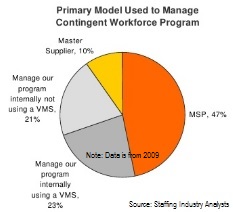 Staffing Industry Analysts says the master supplier method of hiring and managing contingent (temporary) workers is making a comeback, often now in conjunction with a managed service provider.
Staffing Industry Analysts says the master supplier method of hiring and managing contingent (temporary) workers is making a comeback, often now in conjunction with a managed service provider.
In a blog post reference to SIA’s recently completed “2013 Contingent Buyer Survey: Primary model used” the research organization says that this year, “33 percent of buyers with CW programs of less than $20 million in spend used a master supplier as their primary supplier management model, up from just 12 percent in 2009; use also rose notably among buyers in the $20 million to $99 million spend range.”
In a blog post reference to SIA’s recently completed “2013 Contingent Buyer Survey: Primary model used” the research organization says that this year, “33 percent of buyers with CW programs of less than $20 million in spend used a master supplier as their primary supplier management model, up from just 12 percent in 2009; use also rose notably among buyers in the $20 million to $99 million spend range.”
Despite the resurgence, SIA says “global temporary staffing labor is managed either by an MSP or run through a VMS.” The total value of the contracts managed by one or the other of the methods is estimated by SIA to top $100 billion.
SIA lists Fieldglass as the largest VMS, managing $27.4 billion in billings. Allegis Group Services is the largest MSP vendor managing $8.3 billion.
Traditionally, master suppliers were the primary provider of temp and contract workers to a client. They both supplied the workers, and handled much or all the paperwork, even when they subcontracted with other firms to fill orders. As the use of contingent workers expanded across industries and internally across divisions, employers turned to master service providers (MSPs) or vendor management systems (VMS).
MSPs began to take share, in part because they were considered vendor neutral since they sourced firms to provide staffing services, but did not provide workers themselves. VMS became popular mostly at the largest firms, which opted to manage their temporary worker program in-house.
 By 2009, the MSP model was the most commonly used method of managing and provisioning a contingent workforce, according to survey data from Staffing Industry Analysts. That year, 47 percent of the surveyed firms reported using an MSP, with technology and telecom firms most likely to use that model. Only 10 percent of the firms in the survey used a master supplier.
By 2009, the MSP model was the most commonly used method of managing and provisioning a contingent workforce, according to survey data from Staffing Industry Analysts. That year, 47 percent of the surveyed firms reported using an MSP, with technology and telecom firms most likely to use that model. Only 10 percent of the firms in the survey used a master supplier.
Now, the master supplier is “rising from the ashes.”
“What has been established in the last decade is that it’s easier for a master supplier to fulfill certain specialized requirements than have it be a neutral bid every time clients need that resource, be it shift work or short-term needs,” says Kersten Buck, director, strategic solutions at SIA.
Master suppliers today work in conjunction with an MSP. The master supplier fills orders themselves or finds other suppliers, while the MSP manages the program. Says SIA,”MSP manages statement-of-work workers, independent contractors, compliance, invoicing, keeps the customer abreast of trends in the marketplace, etc. ”